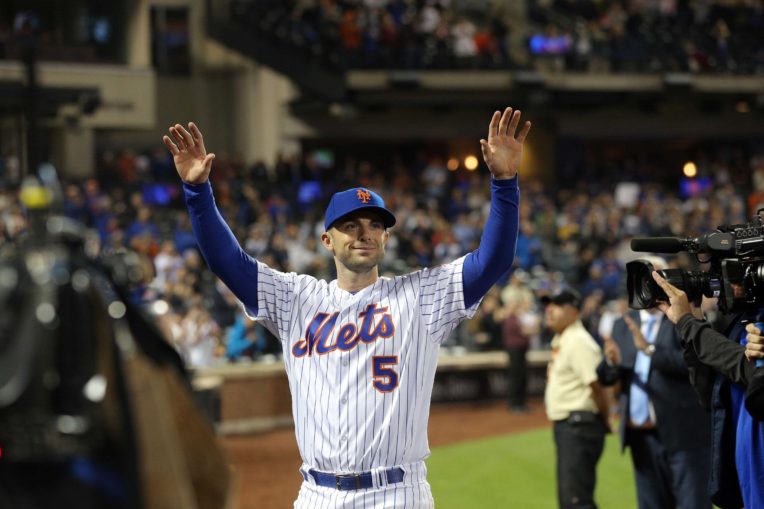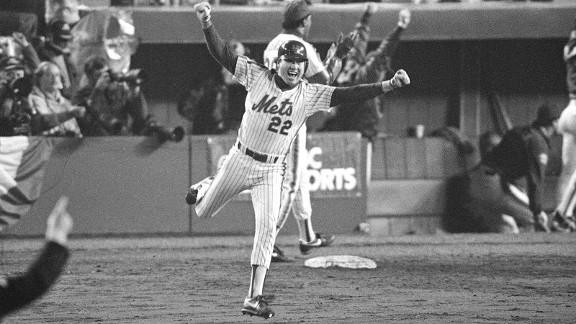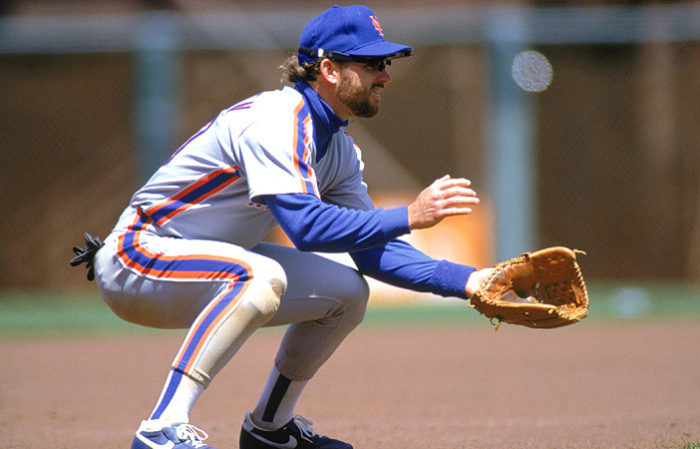
There is no position in the field of play in baseball that has had less consistency, less continuity and is less of a constant than that of third base for the New York Mets. From Ed Charles to Charlie Neal to Charley Smith, the Mets third base bag has been a merry-go-round, populated by no less than 172 different players who have manned third base in Mets history for at least one game.
Yet, with all the changes that the hot corner has seen, it also is home to arguably the best position player in Mets history.
But before we wax poetic about the recent past of the Mets and all the glory of its most recent captain, a brief look at some of the third basemen of the more distant past is in order, as there have been some very good players that have manned third in Mets history.
It started in 1962 with Felix Mantilla the Opening Day starter. Then, as the decade proceeded, there was little order to the hot corner until Ed Charles took over in 1967. Charles finished with 247 starts at third for New York and his veteran leadership was an important part of the team for most of three seasons.
Wayne Garrett stabilized the position from 1969 until 1976. Although he never had that one breakout season that would place him on the five-best list that follows, his presence was invaluable. If honorable mentions were given to a player for consistency and durability, Garrett would be on the list. His 711 games started at third is the third-most in Mets history. Garrett made a nice contribution in the 1969 NLCS against the Atlanta Braves hitting .385 with a home run, a stolen base, and a 1.236 OPS in 15 plate appearances. History will regard Garrett as one of the Mets better third basemen.
Lenny Randle had solid campaigns in the mid to late seventies, punctuated by a 1977 season where he hit for a .304 average, five home runs, 27 RBI, 33 stolen bases, and a .383 OBP. Not bad stats considering the Mets only won 64 games in ’77.
In the early eighties, Hubie Brooks was a constant at third for the Mets. He ranks fourth in all-time games played at the hot corner with 516. His 1981 season earns an honorable mention despite being strike shortened. He finished third in 1981 in Rookie of the Year balloting. Brooks is probably best known as the linchpin in the trade that brought Gary Carter to New York.
From 1985 until 1993, Howard Johnson was a Mets fixture at third. His three 30-30 (home runs and stolen bases) seasons rank him fourth on the all-time list. His 835 games played at third ranks him second on the Mets in that category. More on HoJo below as one of his 30-30 seasons made the top five list (although all of them could have).
In the middle of the Johnson era, Ray Knight had an invaluable 1986 campaign, playing mostly at third as HoJo filled in at shortstop and had injury issues. More on Knight’s 1986 season to follow.
No list of Mets third basemen can be complete without mentioning Edgardo Alfonzo. He does not appear in the list below because he was named as having the best two seasons a second baseman has ever had. Much more on Fonzie can be found in that article here.
Alfonzo played third for the Mets for the better part of five years (1995-1998, 2002). His 515 starts rank him fifth on the all-time Mets list for starts at third. He has a handful more starts at second (524) in his career. Alfonzo’s 1997 and 1998 seasons deserve honorable mention here. In 1997, Alfonzo hit .315 with 10 home runs, 72 RBI, 27 doubles and a .391 on-base percentage. A year later, Alfonzo followed up his breakout season with another solid season. He batted .278 with 17 home runs, 78 RBI and 28 doubles.
Robin Ventura took over at third in 1999 for New York after spending a decade with the Chicago White Sox (1989-1998). He had a tremendous first season with the Mets, which will be recounted below. He is known for hitting 18 grand slams in his career, fifth on the all-time list. He missed out on number 19 because of his now famous “Grand Slam Single” he hit against the Atlanta Braves in Game 5 of the NLCS . A gifted defensive specialist, Ventura appeared on the cover of Sports Illustrated with his infield mates as the magazine queried as to whether this infield was the best defensive grouping ever.
Then of course comes the franchise leader in games played at third base, David Wright. Not only is Wright the franchise leader in games played at third (1586), he is also the leader in hits, runs, RBIs, doubles, and position-player WAR. From 2006-2008, he was undoubtedly one of the best players in baseball amassing a 19.3 WAR over that stretch . In 2013, he was named the fourth captain of the Mets, joining Gary Carter, Keith Hernandez and John Franco.
Wright, to some still the face of the franchise, played third for over a decade in New York starting in the 2004 season. Wright is not just the greatest Mets third baseman of all time, but the greatest Mets position player of all time. And if it weren’t for a man named Tom Seaver, Wright would be the greatest Met of all.
What follows is the list of the five best campaigns a Met third baseman has ever had. It would be easy to just list a couple of Wright’s seasons and Johnson’s 30-30 seasons. But in the interest of diversity (and raw statistics) only one player appears more than once. Please feel free to list your top five campaigns in the comments section below.
5. Ray Knight—1986

Perhaps a surprise entry to some, Ray Knight’s 1986 campaign was a special one, culminating in a World Series MVP. Who can forget the image of Knight rounding third and coming home as Mookie Wilson‘s grounder “gets through Buckner.” It still elicits chills to even the most hardened of Mets fans to watch the end of Game 6 against Boston. Ray Knight also was the key cog in Game 7 to nail down the Mets’ second World Championship.
Very little was expected from Knight as the 1986 season began. He hit a desultory .218 in 1985, and was such a non-factor that the Mets tried to trade him to the Pittsburgh Pirates but failed.
Knight changed his batting stance as the 1986 campaign started and this showed immediate results. In April, he hit .306 with six homers and 12 RBIs. Ron Darling commented during a mid-season interview with reporters, “Besides our pitching, it has been Ray Knight’s emergence that has been the difference. He carried us for a long time.”
Knight finished the 1986 season with a .298 average, 11 home runs, 76 RBI, and a .351 OBP. He also won the 1986 NL Comeback Player of the Year Award.
In the playoffs, Knight had a slow NLCS against his old team, the Houston Astros, but broke out in the World Series. He hit .391 with 5 RBIs to cop the MVP. In Game 6, his single in the tenth inning scored Gary Carter and moved Kevin Mitchell to third. Mitchell scored on a wild pitch, setting the heroics that ensued with Wilson’s at-bat. In Game 7, Knight hit the tie-breaking home run in the seventh off of Calvin Schiraldi to catapult the Mets to an 8-5 win.
Though his time in New York was short, Knight contributed mightily for the Mets in 1986. He will be always be known as a World Series hero.
4. Robin Ventura—1999

Robin Ventura spent ten years with the White Sox before joining the Mets in 1999. In the American League, he was an All-Star in 1992 and a five-time Gold Glove winner. Ventura’s presence caused a shuffle in the Mets infield. Incumbent third baseman Edgardo Alfonzo was moved to second base to replace the departure of the disappointing Carlos Baerga.
Ventura’s first year in Flushing was his best. He batted .301 with 32 home runs and a career-high 120 RBI. He also had a .379 OBP and a career-high .529 slugging percentage. He won his sixth and final Gold Glove Award that year. It was his first in the National League. He finished sixth in MVP voting.
Ventura’s defensive prowess did not go unnoticed, as his appearance on the cover of Sports Illustrated (with the rest of his infield) proved. Were Ventura, Alfonzo, Rey Ordonez and John Olerud the best defensive infield ever, as the magazine suggested? It’s certainly a topic worthy of debate.
On May 20, 1999, Ventura hit a grand slam home run in both games of a double header. He is the only player in MLB to accomplish this feat. His predilection for grand slam hitting did not end with the regular season.
Robin Ventura will forever be remembered as hitting the only “Grand Slam Single” in history. It happened in Game 5 of the NLCS in the 15th inning, as Ventura homered with the bases loaded – but as he rounded the bases, Todd Pratt bulldozed him, hoisting him in the air and preventing Ventura from scoring. The official scorer called the hit a single and Ventura immediately entered Mets lore. Unfortunately, the Mets lost the series with the Braves in Game 6.
Ventura spent only three years in Queens with 1999 his best season by far. He made a lasting impression as a Met despite his brief stay. His lifetime stats were accomplished mostly in Chicago, not as a Met. But his 1999 season belongs on the mantle of Mets history, and it is for this reason that he belongs on this list.
3. Howard Johnson—1991

With the departure of Ray Knight after the 1986 season, the Mets needed a new everyday third baseman. Howard Johnson capably filled that role and became one of the best hitters in Mets history. He was acquired by New York prior to the 1985 season in exchange for Walt Terrell. His breakout year for the Mets was in 1987 when he hit .265 with 36 home runs and 99 RBI. He also added 32 stolen bases, as he and Darryl Strawberry became the first Mets to hit 30 home runs and steal 30 bases in the same season. HoJo, as he is affectionately known, even received MVP consideration in 1987. He was the first switch hitter to join the 30-30 club.
Johnson’s best two years were 1989 and 1991. In both seasons, he hit over 30 home runs and stole more than 30 bases, making him a three-time member of the 30-30 club. He ranks fourth all-time in that department. His stats in 1989 were impressive all around. He finished the year with a .287 average, 41 doubles, 36 home runs and 101 RBI. He also had a career-high 41 stolen bases, 104 runs scored, and a .559 slugging percentage. As a result, Johnson won his first Silver Slugger award. He also appeared in his first All-Star game, where he was the starting third baseman.
But HoJo saved his best year for 1991. He became the leader of the offense after Darryl Strawberry left for Los Angeles in December 1990. After a slow April, Johnson exploded in May and continued his torrid hitting right through September, when he became the National Leagues’ Player of the Month. He ended the year ‘winning’ two-thirds of the Triple Crown, leading the league in home runs with 38 and RBIs with 117. Johnson also added 34 doubles, 30 stolen bases, and a .535 slugging percentage. He made his second All-Star team and won his second Silver Slugger. He finished fifth in MVP balloting.
In 1991, Johnson was among the most feared hitters in baseball and was called by many the best hitter in the NL that year. He was dragged down on MVP voting (and on this list) most likely due to the 31 errors he committed at third, a career worst. He was moved to the outfield to compensate for his poor fielding.
HoJo – always a fan favorite – was, for a time, the greatest offensive third baseman the Mets ever had. Ironically, Johnson mentored the player who would surpass him as the greatest third baseman in Mets history, a player named David Wright.
2. David Wright—2008
The top two places on the list go to the man who’s in the top two on many Mets’ fans lists of greatest Mets ever. David Allen Wright played all or part of fourteen seasons with New York and became the team’s only superstar to play his entire career as a Met. Wright’s close friend Jacob deGrom has a chance to equal that distinction. He is a career .296/.376/.491 hitter and leads the Mets in numerous offensive categories including: RBIs, doubles, total bases, walks, sacrifice flies, hits, times on-base, extra base hits, and WAR.
Wright is a seven-time All-Star (2006-2010, 2012, 2013), two-time Silver Slugger (2007, 2008) and twice a Gold Glove recipient (2007, 2008). On March 21, 2013, Wright was named the team’s fourth captain.
He hit his first walk-off home run on August 7, 2008.
There is so much else Wright accomplished (his prowess in his two World Baseball Classics, for example) that a tome would be needed to properly credit him for his life’s work.
Many seasons could be included in this list, but two stood out early in his career, setting the stage for Wright becoming a dominant force in the NL. In 2008, Wright hit .302 and set career highs with 33 home runs and 124 RBI, which tied the Mets’ RBI record set by Mike Piazza in 1999. He also had 115 runs scored, 189 hits, 42 doubles, 15 stolen bases, a .390 OBP, and a .534 slugging percentage. He won his only Sports Humanitarian Award in 2008. This was, in part, due to the David Wright Foundation that was founded in 2005 to increase awareness about multiple sclerosis and to fund projects and organizations that deal with MS.
1. David Wright—2007
Wright did not elevate himself as one of baseball’s best players until 2007, when he set a career high by hitting .325 to go along with 113 runs scored, 196 hits, 42 doubles, 30 home runs, 107 RBI, 34 stolen bases, a remarkable career high .416 OBP, and a career high .546 slugging percentage. He became only the third Met to have 30 home runs and 30 steals in a season (Howard Johnson and Darryl Strawberry were the others). He also won the first of two straight Silver Slugger and Gold Glove Awards that year. Wright finished fourth in MVP voting in 2007, the closest he would come to earning that distinction.
Although still several years from becoming the team’s official captain, his leadership at even this early stage of his career was remarkable. On the field and off, he showed time and time again the abilities seldom found in such a young player.
“He’s taught a whole generation of Mets how to act,” Mets assistant general manager John Ricco once told reporters.
He also showed a whole generation of Mets fans class, inspiration, and fortitude and that makes him perhaps the greatest position player to ever wear a Mets uniform.















